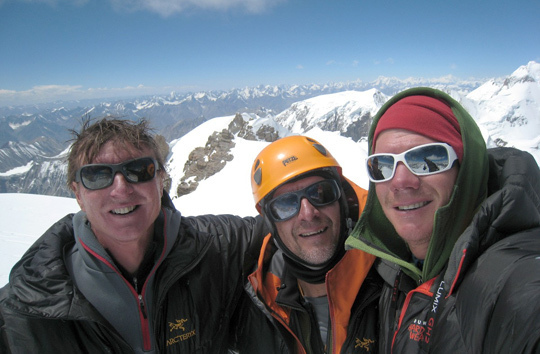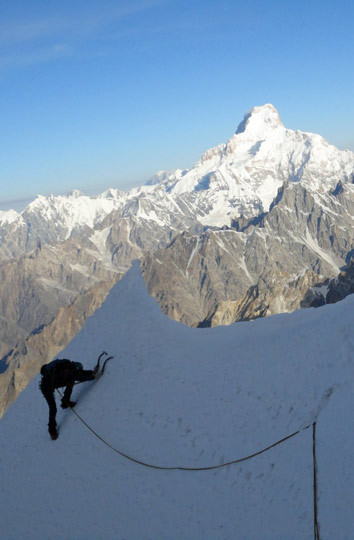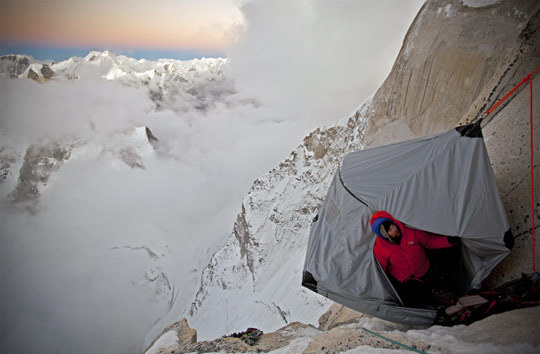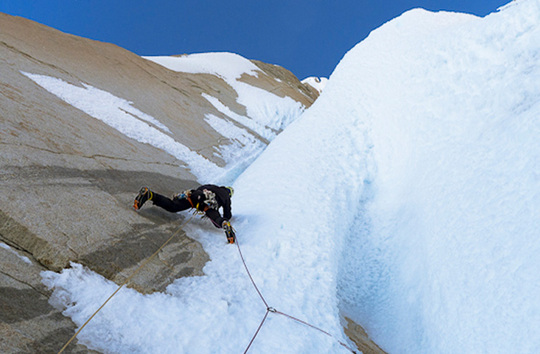It is with great sadness that we learned of the fatal accident of Bj?rn-Eivind ?rtun and Stein-Ivar Gravdal while attempting a new route on Kjerag in southwest Norway. As his ascent with Colin Haley on Mt. Foraker was nominated last year, we had the privilege to have Bj?rn-Eivind with us in Chamonix and Courmayeur. A top alpinist, he was a very open, friendly and humble person. This year his impressive new route on Torre Egger with Ole Lied is one of the six nominated ascents. A detailed tribute will be posted on the Piolets d’Or website in a few days, and we will miss Bj?rn-Eivind very much this March.
In the name of the Piolets d’Or organization,
Christian Trommsdorff
Press Release
For the twentieth edition of the Piolets d’Or, it took a month of reflection and debate for the jury, presided over by Alpinist Editor-in-Chief Michael Kennedy, to select the six routes that they have decided best illustrate exploratory alpinism at a high technical level in minimal style undertaken with consideration for the environment.
Chosen from a list of eighty-eight ascents completed in 2011 on the mountains across the globe, these six routes are testament to the skill and determination of the fifteen alpinists who endured often hostile climates in these little-known mountain ranges in isolated regions. The Indian Karakoram, Xuelian Feng, Kyrgyzstan, Patagonia, Gangotri-Garhwal, Charakusa… autonomy and a strong team spirit are paramount in these rarely visited high altitude areas.
The nominated alpinists will be with us in Courmayeur and Chamonix from March 21-24 to present their routes, meet the public and perhaps be awarded with a Piolet d’Or – honoring the most notable alpine style ascents of 2011.
Pik Pobeda (7439m), Kyrgyzstan

The northern aspect of Peak Pobeda (7439m) showing in green the “Abalakov Route” (6A, 1956, 2939m), Dollar’s Route (Smirnov, 1982), Verblud (Camel) (6b 65 degree, Sokolov-Gorelik, Pobeda West (6918m, Vazha Pshavela) 2009), West Ridge (D.Medzamariashvili, 5B, 1961, via Pobeda West (6918m, Vazha Pshavela), 8650m, 35 degrees), and in red “Dollar Rod” (6b, Durov, Urubko) In Russian Pobeda means “Victory”, the peak was renamed following the end of WWII. Originally it was called Pik 20 Jahre Komsomol, a name given in 1938 by first the ascensionists to commemorate the twentieth anniversary of the Communist Youth Group. [Photo] Mountain.Ru Archives
Pik Pobeda is the most northerly 7000-meter peak in the world. A high-altitude symbol for mountaineers on the Asian continent, its steep and exposed north face is 2500 meters high. Kazakhs Gennadiy Durov and Denis Urubko added a fourth route to the central and highest part of this face, below the summit. Dollar Rod is a committing and technical route undertaken in alpine style, a modern feat. Last November it was awarded the sixth Asian Piolets d’Or.
Saser Kangri II (7518m), India

Mark Richey, Steve Swenson and Freddie Wilkinson on the summit of Saser Kangri II (7518m) formerly the second highest unclimbed peak in the world. The trio climbed the mountain over five days in August. [Photo] Freddie Wilkinson
Americans Mark Richey, Steve Swenson and Freddie Wilkinson’s expedition to the Indian Karakoram is another example from 2011 of exploration and committed alpine style at high altitude. During a two-month expedition, the three alpinists summited the second highest, previously unclimbed mountain in the world, Saser Kangri II. The team reached the summit on August 24 via the steep, 1700m southwest face, after four days of ascent and three bivouacs. The route’s technical difficulties are concentrated in the higher part of the climb.
K7 West (6615m), Pakistan

Nejc or Luka traverses a ridge on Dreamers of Golden Caves, K7 West, Pakistan. The 1600m route follows the south-southwest ridge and reaches difficulties of A2 M5. [Photo] Charakusa 2011 collection
Young Slovenians Nejc Marcic and Luka Strazar, twenty-six and twenty-three years old respectively, reached the west summit of K7 in a three-day, alpine style ascent of the previously unclimbed northwest face via a 1600m sustained mixed route, completing the third ascent of this famous summit in the Charakusa valley. Exploration, technical difficulty, minimalist style and commitment are the characteristics of their ascent. It was their first Himalayan expedition.
Xuelian North-East (6249m), China
Xuelian North-East was the last remaining unclimbed 6000m peak in the Xuelian Feng, a massif in the Chinese Tien Shan. Slovenians Ales Holc, Peter Juvan and Igor Kremser climbed it in alpine style, taking the long and aesthetic northwest ridge over four days, and descending on the southeast side in a day and a half. The technical difficulty and length of this route, climbed in minimalist style, caught the attention of the jury.
Meru Central (6310m), India

Renan Ozturk at the final camp before the summit push on the Shark’s Fin. Ozturk and his partners have spent more than thirty days on the climb over the years. [Photo] Jimmy Chin
Attempted by many expeditions since 1986, this incredible route on the east pillar of Meru Central, the Shark’s Fin, was climbed in its entirety for the first time by Americans Conrad Anker, Jimmy Chin and Renan Ozturk. This particularly aesthetic route has all the difficulties of modern alpinism: rocky terrain involving difficult free climbing and committing aid climbing, and delicate mixed terrain in the upper section.
Torre Egger (2850m), Argentina

“The next morning there was only positivity and every move was an adventure in itself.” – Årtun. Ole Lied leading on Venas Azules. [Photo] Bjørn-Eivind Årtun
The Patagonian spires have always lured the best technical climbers on the planet. A distant land ravaged by the southern winds, its granite peaks covered in the strangest of glacial formations. Rime and ice can cover the walls of these polished rocks, and sometimes coat them completely, depending on the wind direction. At the end of December the entire wall of Torre Egger’s south face was covered in ice. Norwegians Bj?rn-Eivind ?rtun and Ole Lied climbed this vertical tower, taking the alpine community by surprise with their opportunism.